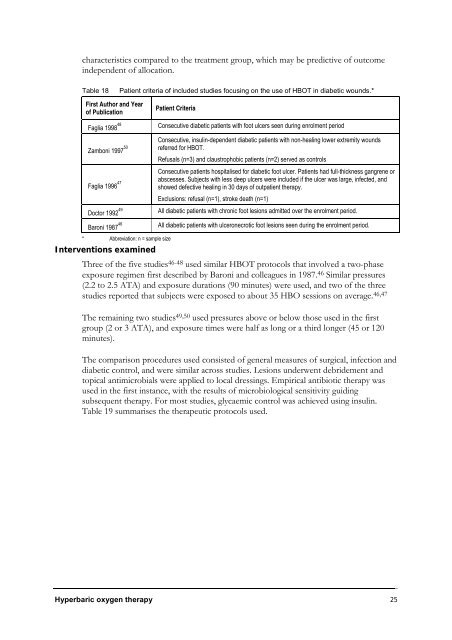Hyperbaric Oxygen Therapy - Hyperbaric Chamber Information ...
Hyperbaric Oxygen Therapy - Hyperbaric Chamber Information ...
Hyperbaric Oxygen Therapy - Hyperbaric Chamber Information ...
Create successful ePaper yourself
Turn your PDF publications into a flip-book with our unique Google optimized e-Paper software.
characteristics compared to the treatment group, which may be predictive of outcome<br />
independent of allocation.<br />
Table 18 Patient criteria of included studies focusing on the use of HBOT in diabetic wounds.*<br />
First Author and Year<br />
of Publication<br />
Patient Criteria<br />
Faglia 1998 48 Consecutive diabetic patients with foot ulcers seen during enrolment period<br />
Zamboni 1997 50<br />
Consecutive, insulin-dependent diabetic patients with non-healing lower extremity wounds<br />
referred for HBOT.<br />
Refusals (n=3) and claustrophobic patients (n=2) served as controls<br />
Faglia 1996 47<br />
Consecutive patients hospitalised for diabetic foot ulcer. Patients had full-thickness gangrene or<br />
abscesses. Subjects with less deep ulcers were included if the ulcer was large, infected, and<br />
showed defective healing in 30 days of outpatient therapy.<br />
Exclusions: refusal (n=1), stroke death (n=1)<br />
Doctor 1992 49 All diabetic patients with chronic foot lesions admitted over the enrolment period.<br />
Baroni 1987 46 All diabetic patients with ulceronecrotic foot lesions seen during the enrolment period.<br />
* Abbreviation: n = sample size<br />
Interventions examined<br />
Three of the five studies46-48 used similar HBOT protocols that involved a two-phase<br />
exposure regimen first described by Baroni and colleagues in 1987. 46 Similar pressures<br />
(2.2 to 2.5 ATA) and exposure durations (90 minutes) were used, and two of the three<br />
studies reported that subjects were exposed to about 35 HBO sessions on average. 46,47<br />
The remaining two studies 49,50 used pressures above or below those used in the first<br />
group (2 or 3 ATA), and exposure times were half as long or a third longer (45 or 120<br />
minutes).<br />
The comparison procedures used consisted of general measures of surgical, infection and<br />
diabetic control, and were similar across studies. Lesions underwent debridement and<br />
topical antimicrobials were applied to local dressings. Empirical antibiotic therapy was<br />
used in the first instance, with the results of microbiological sensitivity guiding<br />
subsequent therapy. For most studies, glycaemic control was achieved using insulin.<br />
Table 19 summarises the therapeutic protocols used.<br />
<strong>Hyperbaric</strong> oxygen therapy 25



